Below are some of the scans of my notes, breaking down the main beats of a story, and what they mean.

 As a series of experiments, multiple stories had to be created using the main narrative beats, starting with the setting, the scenario, the progressive complications until finally the resolution.
As a series of experiments, multiple stories had to be created using the main narrative beats, starting with the setting, the scenario, the progressive complications until finally the resolution. 
Other examples can be found below:
Once upon a time...there was a dog, a great big hairy dog who sat on his own in the middle of a front yard, watching cars and pedestrians zoom and amble by.
And every day...the dog would run round and round in circles, chasing his tail from dusk till dawn.
Until one day...the dog’s tail fell off.
And because of that...the dog decided to bury his tail.
And because of that...the dog became complacent and slept from dusk till dawn on the front yard.
And because of that...the dog became increasingly lazy with each passing day and forgot how to run in circles.
Until finally...the dog missed his tail so much that he forced himself to carry on running round and round in circles, hoping in vain to catch his non-existent tail. Eventually he ran round so much, he dug himself into the ground and unearthed his lost tail.
And since that day...the dog was reunited with his lost tail and decided only to run round in circles once per day, and resting sensibly.
And the moral of that story is...don’t lose your tail(?)
Once upon a time...there was a jockey who wasn’t very good at taming his new horse.
And every day...he would try and try and try to mount up onto the saddle, failing miserably each time as the wild steed would reject him.
Until one day...the jockey had an idea. He decided to tie the horses legs together, so it was unable to kick.
And because of that... the jockey attempted to mount up again, only to be thrown off by an increasingly frustrated horse.
And because of that... the jockey had another idea. He decided to tie the horses head down, to ensure it couldn't rear and buck.
And because of that... the jockey attempted to mount up once more, only to be thrown off again by a now livid horse.
Until finally... the jockey untied the horse's head and legs, and apologised profusely. The horse, in repayment, demanded that the jockey act as his steed forever after.
And since that day... the jockey has labouriously carried his steed on his back till the end of his days.
And the moral of that story is... try asking nicely.
Typical examples of how you can create scenarios using that structure. There are certain elements within these little narratives that are crucially important in setting the scene, and fully realising a scenario and the characters within it. Elements such as describing the student as the PROUD owner of games console, a GREAT BIG HAIRY dog or a LIVID horse. Immediately this speaks volumes as to the nature of the characters, and perhaps their motives, lending themselves to the progressive complications. If somebody is proud of something, then you know a complication would arise where their pride would be wounded or taken away from them etc- the character then compliments the narrative. The same too can be said of how the progressive complications can lend themselves to the inevitable outcome, and how as a writer you can use your instincts to play on that inevitability and twist it.

http://www.dvoted.net/Knowledge/Articles/Film-pre-production/Some-synopsis-examples/
Below is an example of one of the synopsis entries in the above link:
''It’s Chicago in the 1920s. The Prohibititon is in effect, which makes the illegal market for hard liquor a profitable business to be in. It’s quickly taken over and controlled by the mob. On top of everything is the cold-hearted businessman and mob-leader, Al Capone. He is untouchable, but others are soon to be too.
Federal agent Elliot Ness is a newcomer at the Chicago Police Department, with the purpose of taking down Al Capone. He quickly realizes the extent of corruption among the crooked cops in the department and assembles a new team of mob-fighters, including the veteran patrolman, Jimmy Malone, who does not have a dishonest bone in his body. He introduces Ness to the Chicago underground and becomes his mentor and friend.
Al Capone pays no attention to the new enforcement, but when Ness and his team suddenly raid one of Capone's liquor warehouses and are named ”The Untouchables”, he gets pissed off. Now the real war begins. Ness has to bring his family to safety in another town. His newly arrived federal accountant is killed by Capone's prime hitman and so is his main witness, a captured gangster.
The effort seems meaningless at this point, but Malone finds the key to the puzzle, Capone's bookkeeper. Unfortunately Malone is killed before he can bring the bookkeeper in. This triggers Ness. He and the last member of his crew, George Stone, get hold of the bookkeeper and secure his witness statement in court, to bring Capone to face a 10 year sentence. Peace in Chicago is restored... for a while.''


''Two lonely scarf-clad buskers find themselves occupying the same space in a dishevelled underpass. At first they are rivals, and soon lose their ability to play their beloved music by breaking their instruments in a furious face-off. As they spiral into enemies, they both depart on their own, following their path laid before them by the endless ragged scarf trailing off. As they wander alone, they soon become entangled in their frustrations and desire to play music once more, only to find in their dance-like movement they have more in common than they first realised...''
I really like how the Alfred Hitchcock break-down of his film 'Lifeboat' really demonstates the power of good character intros. Characters are the backbone to any story, and are the driving force of any story. So it is essential that when they first appear, everything about them should be made clear, even if it is revealed at a deliberately slow pace- i.e morally ambiguous characters, for example. Some of my all time favourite character introductions come from director sergio leone, famous for his wild west films.
Reference Videos.
As I mentioned earlier, sergio leone is a huge influence on me and will effect how I will storyboard my story, focusing on emulating the classic mid-shots and close-ups that defined his woks. Below is a prime example of his wonderful casting, compostion and ability to weave tension right up to the moment of conflict.

It seems pretty straightforward, and in truth the story is rather simplistic, however that is the beauty of it. A simple story can be enriched by interesting framing, and compelling storytelling interwoven into the plot. Above and below I have tried to capture the main beats, where the story shifts in another direction at key points. The duel playing, the breaking, the argument, the parting of ways, the entanglment, the realisation of the link, the dance-like union.
 There are certain other elements for the storyboard that now need to be applied. I have to consider not only how the main beats punctuate this story, but also how my frame composition compliments the soul of the story, and adds to the momentum of the plot.
There are certain other elements for the storyboard that now need to be applied. I have to consider not only how the main beats punctuate this story, but also how my frame composition compliments the soul of the story, and adds to the momentum of the plot.
The first page has the opening establishing shot, the underpass setting the grimy tone which immediately reflects the dejected and solemn mood of the buskers. One of my favourite shots is when the camera pans to the side, so the framing of the one character at the foreground slowly reveals the second character in the background, adding to the drama.

With the second sheet I directly borrowed some of leone's classic close ups, using the perspective angle and repeated cuts backwards and forwards, zooming in bit by bit as the face off reaches its peak. Also the dynamic of flitting between extreme close-ups and wide-shots is also very effective. It simultaneously keeps the audience aware of the space and environment, whilst immediately thrusting you intimately into the action.
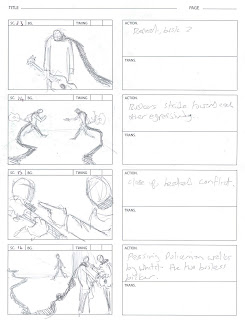
Symmetry plays an important role in this storyboard, as both buskers in their rivalry mirror each other in almost everyway. This is enforced by the scene where both stride across the underpass toward each other agressively. The following scene shows their clash, and again is a close-up, making the drama intimate. The final scene introduces a third party, seen strolling in the background. My composition was crucial here as I needed to shift the focus away from the argument (which at the moment is an eye-catching scenario) and I employed an age-old visual plot device of using the environment or objects, in this case the scarf, as a physical element that draws the eye towards a new focul point, not to mention pushing the bickering pair to the right so as to give wide space to the left for the eye to naturally sweep over at first glance. Very effective.
Here body language becomes key in the absence of dialogue. The third man turns out to be a policeman, made clear by his iconic bobby helmet, and quite literally splits the pair apart, wedging himself inbetween, enforced by his positioning in the center of the frame. With clear character posing, the outstretched hand of the policemen, the slouched demeanour of the exiting buskers and last shot of the pair walking away from each other all do their part to cleary and effectively tell this part of the story.
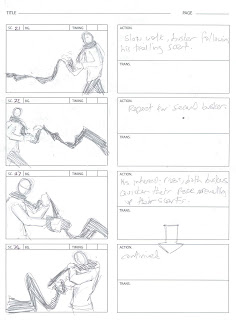 Now dejected, the pair follow their scarf. Here body language works in my favour once again, with each step their frustration becomes more apparent as they grapple with the scarf.
Now dejected, the pair follow their scarf. Here body language works in my favour once again, with each step their frustration becomes more apparent as they grapple with the scarf.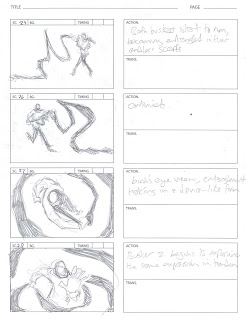
Its here that the story turns into its dance-like form, with the scarf literally taking a life of its own. Overhead shots are useful here as the framing allows the scarf to ribbon around the shot, creating a swirling motion.
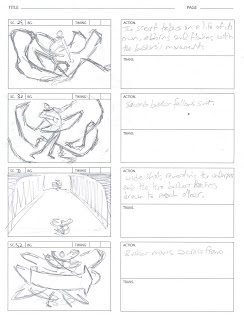
There are often alot of films that blur the action with close-up after close-up, which makes the entire sequence very unreadable- a pet hate of mine, despite how visceral the experience can still end up being, so with the dancing I actually made the composition relatively mundane, and made it so the action in the frame is readable, coherent and speaks for itself. The camera work doesn't need to do much else here.
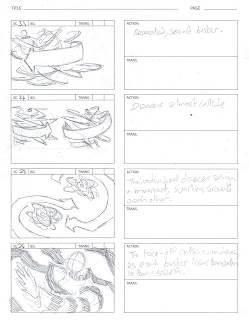
Once again I apply the overhead shots where needed, the pattern and movement of the swirling myriad of scarf can be quite beautiful, and really enforces the dance aspect to this sequence.
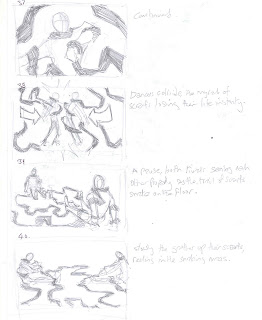
In the above sheet (I ran out of storyboard paper so continued on plain) the dance reaches its peak and subsides as they collide. There are two things that were important in this sequence. Firstly the 'aftermath' of their collision needs to force both parties to face each other during the silence, again continuing the miroring symmetry, and secondly to show the scarf now lifeless and bereft of movement as it snakes along the ground which symbolises the end of the dance.
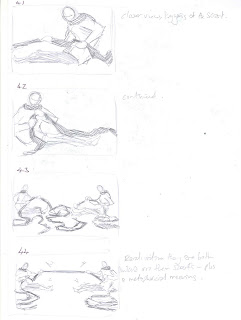
The moment the pair realise their scarfs are not individual but are infact one and the same, that physical link is the defining moment of the entire story. And, usually, such key moments are given a wide birth in their framing for the image to engrave itself in people's minds.
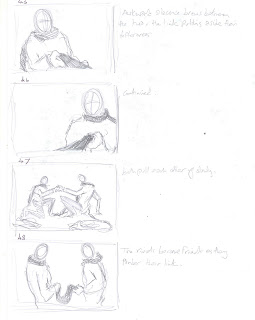
Simple cuts from close ups to wide shots add to the drama as the pair draw closer and closer until in the last frame they are stood opposite each other, both looking down at the one physical link between the two before they burst into dance, this time in union. Again for the action to be readable, the framing is relatively mundane here as the energy within the four walls is enough to keep you occupied.
Feedback;































 As you can see in the above and below pictures, Oliver Jeffers uses existing newspapers, maths papers and book covers to illustrate on, linking the thematic element of books in the narrative.
As you can see in the above and below pictures, Oliver Jeffers uses existing newspapers, maths papers and book covers to illustrate on, linking the thematic element of books in the narrative.


